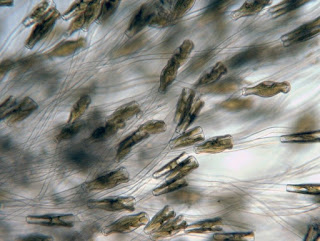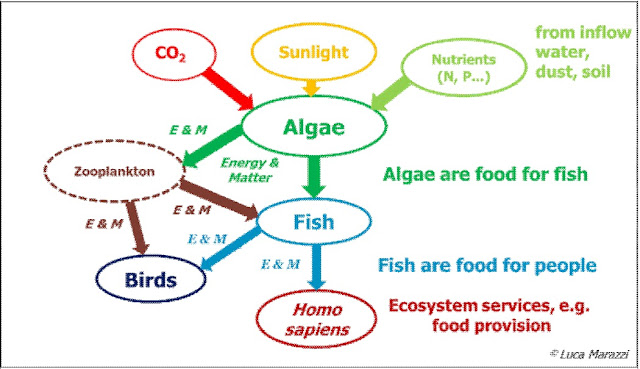Diatom of the month – August 2016: Didymosphenia geminata
by Luca Marazzi*
Many algae are able to form blooms, sometimes releasing dangerous toxins for aquatic organisms and people. Cyanobacteria are most infamous for producing blooms such as those ongoing in Florida's coastal waters, but other algae, including diatoms, can create such vast colonies too. The large (100,001-1,000,000 µm3) asymmetrical biraphid Didymosphenia geminata, or colloquially ‘didymo’ is one of them; it attaches to stones in rivers by stalks (made of mucopolysaccharides, long chains of sugar molecules) that can be 1 m long! Didymo is invasive in Argentina, Chile, and New Zealand, where this video was released in 2008 to inform the fishing community that they should clean and dry all their gear to avoid spreading this species to other water bodies.
Many algae are able to form blooms, sometimes releasing dangerous toxins for aquatic organisms and people. Cyanobacteria are most infamous for producing blooms such as those ongoing in Florida's coastal waters, but other algae, including diatoms, can create such vast colonies too. The large (100,001-1,000,000 µm3) asymmetrical biraphid Didymosphenia geminata, or colloquially ‘didymo’ is one of them; it attaches to stones in rivers by stalks (made of mucopolysaccharides, long chains of sugar molecules) that can be 1 m long! Didymo is invasive in Argentina, Chile, and New Zealand, where this video was released in 2008 to inform the fishing community that they should clean and dry all their gear to avoid spreading this species to other water bodies.
Fig. 1. (top) Didymosphenia geminata (scalebar = 10 µm; photo by Mart Schmidt); (bottom) numerous cells and mucilage stalks from South Boulder Creek (November 2011) - credit/source: Sarah Spaulding (http://westerndiatoms.colorado.edu).
This diatom is also
widely present in the United States, Europe, Russia and parts of Asia (Fig. 2),
and it surprisingly occurs mostly in rivers and streams that are oligotrophic (with scarce nutrients) and unshaded,
rather than eutrophic (with abundant nutrients), as is the
case for many cyanobacteria blooms. Interestingly, stalks
and thus colonies are larger with lower nutrients, as D. geminata cells compete for scarce phosphorus (P), an often limiting nutrient2; blooms are due to a
phenomenon called oligotrophication, or nutrient depletion in turn linked to
acid rain, nitrogen enrichment, snowmelt and growing season timing shifts, and
lower P in the oceans due to reduced salmon populations3. High light
levels are also required by this species to produce the stalks that comprise most
of its blooms biomass.
The discovery that this diatom preferentially
forms blooms with [P] < 1-2 µg/L (or ppb, parts per billion) stems from a
sequence of experiments (see Fig. 3), and studies culminating in Bothwell and
colleagues’ epiphany that blooms do not seem to persist despite, but because
of, low P3.
Fig.
3. Experimental flume on the bank of the Waitaki
River (New Zealand). Source: Bothwell & Kilroy (2011).
In the first place, the current spread
of the “woolly-looking thick mats” of D.
geminata started with fisher people accidentally transporting its cells on felt-soled
waders, and fishing gear (Fig. 4)4. Thankfully, initiatives to stop
the production of this type of boots are taking place, a simple and direct
measure to avoid, or at least limit, the associated negative impacts on the quality
of drinking and recreational waters in many rivers worldwide.
Fig.
4. Didymosphenia geminata bloom
(Heber River, Vancouver Island, September 1989), in Bothwell et al. (2009).
- Source: https://www.invasivespeciesinfo.gov/aquatics/didymo.shtml
- Kilroy C. & Bothwell M. (2011). Environmental control of stalk length in the bloom-forming, freshwater benthic diatom Didymosphenia geminata (Bacillariophyceae). Journal of Phycology 47: 981–989.
- Bothwell M.L., Taylor B.W. & Kilroy C. (2014) The Didymo story: The role of low dissolved phosphorus in the formation of Didymosphenia geminata blooms. Diatom Research 29, 229-236.
- Bothwell M.L., Lynch D.R., Wright H. & Deniseger J. (2009) On the boots of fishermen: the history of didymo blooms on Vancouver Island, British Columbia. Fisheries, 34, 382–388.







Comments
Post a Comment